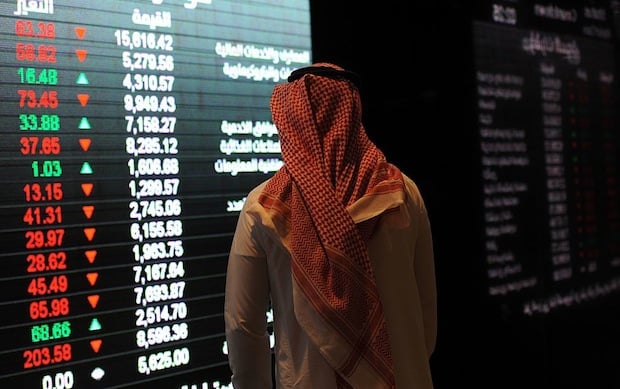Saudi reforms should bring flood of foreign funds in 2018
Reversing the trend would shift the outlook for an economy which shrank last year for the first time in nearly a decade

Saudi Arabia’s inclusion in global equity indexes and the planned privatisation of oil company Aramco are expected to bring big inflows of overseas money into the kingdom next year.
This should help Riyadh rebuild its financial reserves and fund investment plans after the 2014 plunge in oil prices that cut export earnings and deprived the banking system of funds.
Reversing the trend would shift the outlook for an economy which shrank last year for the first time in nearly a decade.
The interest rate swaps market, which bankers use to hedge against future fluctuations in money flows, has begun to reflect these expectations in recent weeks.
The one-year riyal IRS has sunk below the one-year US dollar IRS for the first time since the global financial crisis at the start of this decade – a bet that the Saudi money market will be flush with funds in 12 months’ time.
“It’s quite a change – before, the issue was a shortage of liquidity. We now face a situation in which we’re about to have too much liquidity,” said Hans-Peter Huber, chief investment officer at Riyad Capital, a top Saudi investment bank.
“Massive inflows are to be expected over the next two years.”
The one-year IRS spread was a negative 12 basis points on Thursday. Before the oil price plunge, the spread hovered around plus 60 bps, and it soared to a peak of 203 bps in 2016 during Saudi Arabia’s liquidity crunch.
The inflows are likely to boost foreign reserves. The central bank’s net foreign assets have slid to $480bn from a peak of $737bn in August 2014, raising concern about Riyadh’s long-term ability to support its currency.
Ehsan Khoman, head of regional research for Bank of Tokyo-Mitsubishi UFJ, said they could rebound by $30-40bn before the end of 2019.
Capital inflows may also supply enough money in the banking system to support a pick-up of private investment and a gradual economic recovery in the next few years.
“The worst is probably behind us in terms of economic activity,” said Garbis Iradian, chief Middle East economist for the Institute of International Finance, a global financial industry association.
ARAMCO
Officials predict the sale of a 5 per cent stake in Saudi Aramco will raise $100bn. It was planned for late 2018 but after delays in preparations, bankers now expect early 2019.
Meanwhile, MSCI is expected to decide to add Saudi Arabia to its emerging market index in June, with the change taking effect in stages from next year. FTSE Russell decided last month to upgrade Riyadh to emerging market status.
Read: MSCI’s Saudi decision will be independent of Aramco listing
This will attract portfolio funds. Saudi Arabia could see $30-45bn of portfolio inflows in the next two years if it reaches the same level of foreign ownership in stock markets as the United Arab Emirates and Qatar, according to investment bank EFG Hermes.
Read: Saudi to join FTSE emerging index from next March, attract billions
This month Riyadh took another step towards boosting fund inflows by listing $54.5bn worth of local currency government bonds on its stock exchange. That makes it easier for overseas investors to buy and trade them.
In addition to Aramco, Riyadh has slated dozens of enterprises and assets for privatisation in the next few years, aiming to raise $200bn. Bureaucracy and legal uncertainties have stalled the programme, but it may start to move ahead later this year.
Khoman estimated privatisations other than Aramco could create a total $30-35bn of capital inflows in the next five years, assuming necessary legal changes were made such as lifting ownership ceilings on non-listed entities.
Foreign direct investment in industries which Riyadh is just starting to develop, such as tourism, technology, logistics and infrastructure, could also become significant. Khoman said inward FDI flows, $7.4bn in 2016, could at least double in the next few years.
RISKS
There are risks to the outlook. The most recent forecasts for the Saudi economy assume Brent oil, now at $74 a barrel, will average at least $60 this year. If it drops much below that level, the government might have to resume drawing down foreign reserves heavily to pay its bills.
This could scare away some foreign investment and perhaps cause Riyadh to further postpone the Aramco sale.
Many analysts think Aramco is more likely to raise $50-75bn, significantly lower than the government’s $100bn estimate.
Foreign investors are expected to buy most of the stake, but it is unclear how much of their money will be added to foreign reserves. More than half may be allocated to the Public Investment Fund, Riyadh’s top sovereign fund, for reinvestment abroad, Iradian said.
One wild card is the money which private Saudi citizens transfer abroad; if this increases because of political or economic instability, it could offset much of the fund inflows. Bank for International Settlements data shows private Saudi deposits at banks abroad jumped $18bn in 2017.
“The November 2017 crackdown on alleged corruption among the kingdom’s elite may have accelerated the pace of capital outflows,” Iradian said.
But Huber predicted the central bank’s main policy challenge next year would be absorbing excess funds from the banking system, to prevent them from destabilising markets.
“When oil prices were high before 2014, authorities focused on controlling excess liquidity. They will be back to doing that again,” he said.
